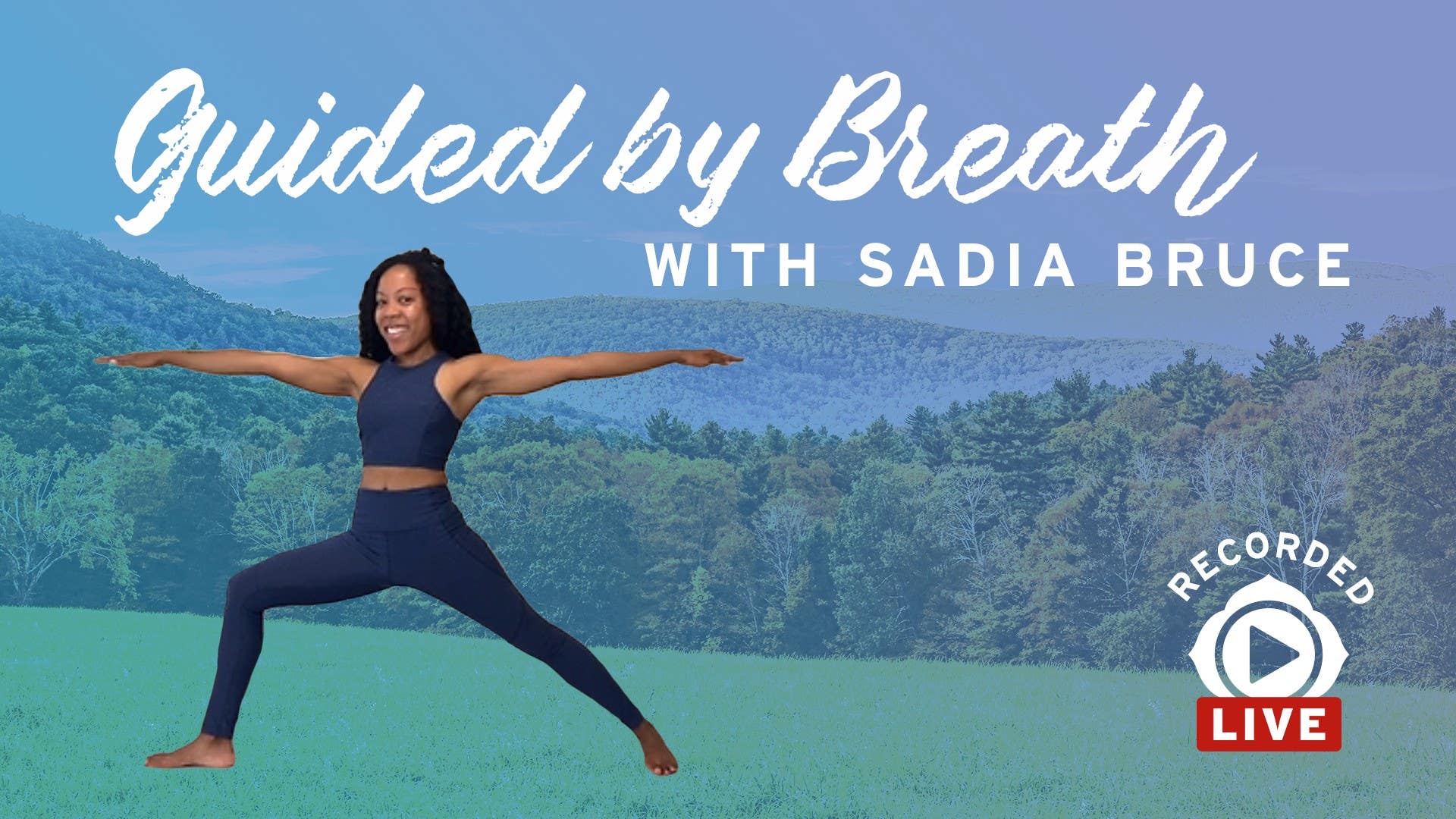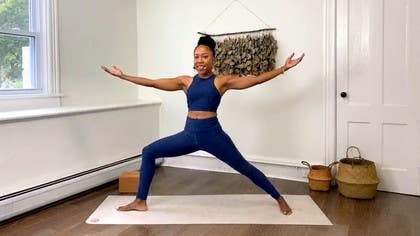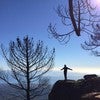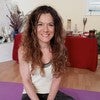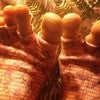Description
About This Video
Transcript
Read Full Transcript
Hi, my friends, new and old. Welcome to the very first episode of Guided by Breath. My name is Sadia, and I'm so incredibly glad that you're here and that I'm here and we're here together. Let's practice, shall we? Today, and every day of the show, actually, we're just going to be dropping very deeply into the body home. We're going to do this thing I call returning the body to the breath. So the intelligence of the breath is always there moving through the body, right? And it's perfect as it is. We don't have to tell the breath to do the magic that it does. So what we're trying to do is access that magic and remind ourselves that it's in there, in us as us, right? So we're going to begin in a seated position. I'm already there. I happen to be seated in Virasana. I'm sitting on top of a block and you're welcome to do that as well. You can pad your knees if you like. Of course, you are welcome to take some other alternate seat, whatever you choose to do is perfect, but we'll come meet in a seated position. And then once you're there, you can go ahead and close your eyes. And then with the eyes closed, right, that the mind's eye takes over. And let's use that eye, which is quite, it's all seeing, right? Use it just to do a scan of your body. And to start, we're just using the mind's eye just to observe are there places where we could adjust so that we find comfort in the seat. So we want to make sure that we're in a seat that we can sustain for a little bit. Roll your shoulders back and down a couple of times, noticing how that brings this brightness to the chest, let the upper arms be heavy, elbows are heavy, hands can rest on your on your thighs. And then after you found this kind of baseline comfort in your seat, draw your attention to your breath and just witness the breath. Witness the inhales and witness as the inhales just surrender themselves to an exhale, how the exhales turn themselves over to an inhale and just on and on this dance of the breath cycle. And just allowing that dance to happen in you. Relax your face, soften the brow and the eyes. Relax your cheeks, your jaw. Draw your attention to the roof of your mouth and just gently energetically lift the roof of your mouth up towards the crown of your head, creating sort of this cavern inside of the skull. And maybe to soften the body, maybe with every exhale allowing the body to soften. And now that we've invited both the mind and the body to let go, observe how the breath is a little bit more expressive, maybe a little more free, maybe a little more expansive. And then bring your palms together at the center of your chest into Anjali Mudra and bow your head to your hands and be honoring your breath, setting perhaps an intention for your practice or dedication. And then release your hands to your thighs, float your eyes open, slowly lift your head up, try to lead with the back of your skull, hello, extend your arms out to the sides. In fact, turn your palms forward and see how that turning forward of the palms, the entire arm revolves that way. And then as you exhale, you'll turn your palms back. Let the upper arm bones also follow that rotation. Let your shoulder heads round forward. And then inhale, turn your palms forward, feel the arms continue that rotation, feel the chest rise, finish the inhale. The exhale comes, turn your palms to face down, let the entire length of the arms roll forward, including the heads of the shoulders. Then inhale, turn your palms forward, finish that inhale as you sweep your arms around and up and as you exhale with the full length of your exhale, lower your arms by your sides. We'll just raise and lower the arms a few times, begin to inhale, sweep the arms up, pause, maybe the palms touch and as you exhale, feel the belly draw in and out, feel that descending quality of the exhale as you lower your arms. A few more times like that, inhale, sweep the arms around and up, begin to exhale, lower your arms by your sides, again like that, begin to inhale. So the breath happens and then we move in response to the breath. The exhale begins and we move in response to the exhale. Once more, inhale, sweep the arms around and up. This time as you exhale, please lower your arms to shoulder height with your palms facing down and as you next inhale, turn your palms to face up, lift the sternum, the center of your chest, keep your neck long, finish the inhale. As the exhale comes, roll your arms and your palms down, round the shoulders a couple more times like that, begin to inhale, turn the palms and the arms up, exhale, reverse, a few more like that. So I'll stop cueing the breath and I'll do this throughout practice, but your job is to stay incredibly attuned and curious about the rhythm of your own breath and to let your body be dancing to that rhythm, to be responding to that rhythm, to be expressing that rhythm a few more times just like this and let yourself stay supple. So don't feel as though you have to be sort of rigid and linear and looking like Nadia Komenhage. That's an Olympic gymnast for the young people tuning in. Begin to inhale, turn your palms up, lift your chest. Once more as you exhale, round forward. As you inhale, turn your palms up, sweep your palms up and as you exhale, once again draw your hands down the center line of your body and just pause for a moment with the eyes closed or the gaze soft, noticing the state of the body and the breath and just witnessing and experiencing and continuing to drop more into the body and way actually from the mind. You can release your hands and then let's come to a tabletop position so of course you'll face the top of your mat. You'll come to a tabletop position, allow yourself to arrive there. So I like to like, I don't know, like a little baby bear, a cub and kind of crawl myself into into tabletop position. Spreading the knuckles of your fingers, letting the hands sort of be like feet against the floor, against your mat, little gentle lift of the centers of your palms and then get weird, get a little weird. I'd like to be weird, it's healthy and then you just move around your joints, let your elbows bend, move your tailbone around, the pelvis, the hips move. So allow yourself to sort of have an embodied experience, right, of arriving in this tabletop position. You can make circles with your hips as you like but whatever movement you're doing just be free with it. It doesn't have to be uniform or even, let it be organic and rather than just doing this in a mechanical way because I've told you to do it, can it be like this moment of inquiry, checking in with your body, what's tight, what's open. And then begin to make all of your weirdness smaller and smaller until you're in a neutral tabletop position and pause and again just witnessing the state of the body and the mind. And as you now begin to tuck your toes under, release your belly, reach your heart forward, looking forward so your neck stays long. The exhale comes, feel your belly draw in and up as it does and then find a cat pose, tuck your chin, curve your spine, keep going like that. Listening and responding, dancing right to the rhythm of your breath. So developing, you know, independence, developing actually deep listening to the breath and to the self and of course I don't have to tell you that that is a metaphor, it works in other areas off of the mat. After your next exhale you come to a neutral tabletop position and then come to stand on your knees and once you're standing on the knees again just being very supple and then I'd like you to roll your shoulders forward, round your spine, draw your arms forward, begin to inhale, undulate your spine, lift your chest up and open your arms. We're going to keep moving like that, exhale rounding forward, begin to inhale, lift the chest and open the arms and you're going to keep going like that. At the pace and at the rhythm of your breath, allowing yourself to express as breath. So rather than moving and kind of breathing as this thing you're doing on the side, you're moving as breath. So once more like that you can continue to go at your pace. The next time you're in the lifted position you can just pause for a moment, draw your big toes together, separate your knees and just come to a child's pose. Let the elbows rest on the floor, let your head rest on the floor and pause and just witnessing and start to crawl your hands forward and pause here, breathe into the sides of your body and receiving the breath in, feeling what happens on the breath out, how the body responds on its own and let it do that. And paying attention too of course to the inhalations. And as the next inhale rises, drag yourself forward to this very wide cow pose, open the chest and as you exhale downward facing dog, lift your hips up and back. The feet are probably pretty wide at this point, that's great, so nice spacious dog pose. You can bend your knees one and then the other and again less mechanical, stay weird forever even in your down dog and less mechanical, more exploratory, less certainty and more curiosity everywhere but especially here right now. Come to stillness in your down dog and pause. You might like to keep your knees bent, that sometimes feels excellent. You might like to extend your knees, allow yourself the pleasure of deciding what it is you need and you want in this moment. But as you begin to inhale next, lower your knees to the floor at the same time, release your belly, open your chest, cow pose, exhale to child's pose, feel that quality of the exhale, how it matches the movement and the shape. Inhale and come forward to cow to receive that breath in and as you exhale downward facing dog, do that again. On the rhythm of your breath, you begin to inhale, lower the knees, release the belly, open the chest, start to exhale, feel how the belly engages and you respond by making your way back to child's pose. You inhale and come forward again and as you exhale downward facing dog, rising in your dog pose. When you're ready, walking your hands back towards your feet and finding Uttanasana standing forward fold, softening your knees so you can spill your pelvis forward and let the spine spill out of the bowl of the pelvis. You might be tempted to shift your weight from side to side. In fact, you can go ahead and do that and explore. See what gravity and pause for a moment, giving the weight of your head to gravity, letting the neck soften. Great. Interlace your hands behind your lower back to the webbing, draw your elbows together, lift your shoulder heads up, try to keep your neck supple and as you inhale, you can bend your knees as in chair pose, lift your chest and straighten your arms to whatever degree you can, trying to keep the heels of your hands touching. Take some breaths here. So there's some muscular effort. There's some release of the fronts of your shoulders. There's lots of mechanical things happening, but let it just be an opportunity for you to continue to allow your body to just be immersed in your breath. Take one more breath and feel that subtle expansion of the chest. And as you exhale, hinge forward, release your hands to the floor. Place your left hand on the floor. You can be on fingertips on palms. If you have a block handy, you can place a block underneath your hand, but it's directly underneath your nose. As you inhale, bend your left knee, reach your right arm up to the ceiling. So you're just doing some open twists in Uttanasana. As you exhale, come to center, switch. Inhale, reach your left arm up, open. Exhale, switch sides. And we keep going like this at the rhythm of your breath, making the transition on the exhale opening on the inhale. The next time you're on the right side, pause there, take a few breaths there and feel whatever is there to be felt. Let also your breath speak to your body as your body is in the shape. And as you next exhale, you'll come to center and you'll open to the left side and you'll pause there. And same thing, let the breath and the body leave them alone now. Let them talk to each other. You take one more breath and then as you exhale, release your hand to the floor, release your head, soften, bring your hands to your ankles. And we're going to do another slightly weird thing. You're going to, I'll explain it before I do it, but we'll walk our hands up the body as we roll ourselves up to standing, but we're also going to walk forward. So I don't know how to describe it. I guess it's like the crypt keeper or Frankenstein waking up or something, but let it be slow.
Let it be a moment of, it's also like the evolution of humans. And then once you've evolved and you're fully bipedal, you can stand at the top of your mat and then just pause there and let yourself be really supple in Tadasana. For me, I have to invite my body to be supple. It doesn't always just, you know, soften. So you may have to do that. And then pause, rest your hands on your body, close your eyes for a moment and just feel the movement of breath in your body. What do you observe about the connection between your body and your breath at this point in practice? And then release your arms by your sides. As you inhale, sweep your arms around and up in an organic way. Begin to exhale and hinge yourself forward to Uttanasana. We're going to move a little like that. Inhale, sweep your arms around and up. Exhale, hinge forward, soften your knees, spill your pelvis forward, reach your heart forward and then surrender to the shape. A couple more times like that with the rhythm of your breath. So trying to get ourselves to really be so tapped into our own rhythm that the body is now expressing the breath. The next time you're upright, bring your palms to prayer. As you exhale, draw your hands down the center line of your body and pause there for a moment. Release your arms by your sides. And then extend your arms out to the sides again. And as you inhale, turn your palms up. So we've done this a few times. Now as you exhale, turn your knees in and roll your shoulders forward. So now the lower body is playing in this shape too. Inhale, turn your feet so that they're parallel. Open your chest, open your arms. As you exhale, dial your whole front body in. Inhale, feet parallel, lift your chest, open the arms. Exhale, reverse. Keep going like this at your own pace. You might like to move incredibly slowly. You might like to move a little bit more quickly. You might like to do a little mixture of both. But the point is, explore. A couple more passes like this. Exhale and pause for a moment. Let your head go. And then start to inhale, reverse, opening your body, receiving that breath in, releasing your arms by your sides. Another inhale will arise, and you'll sweep your arms up. As you exhale, you'll hinge forward. As you inhale, prepare pose, lift your chest, and then exhale, forward fold. So sun breath, inhale, sweep your arms around and up. Your palms can touch. Exhale, tadasana, mountain pose. We'll add a little more this time. Inhale, sweep your arms around and up. Exhale, hinge forward, utanasana, standing forward fold. Inhale, prepare pose, lift your chest, and as you exhale, plant your palms, bend your knees. Let's step back to a plank pose, and we'll pause there. You can lower your knees if you like, whichever you choose to do, whichever works for you in this moment is fine. And you take a few breaths here, and seeing that even in your plank pose, there is this softness of breath. There is this quality of being curious about your practice, this quality of being curious about the connection between your breath and your body, and how the body can express itself as breathtaking. Inhale there. As you exhale, lower yourself all the way down to the floor. As you inhale, baby cobra, lift the center of your chest.
Inhale, lower down, and then press yourself back to tabletop for a moment. Tuck the toes under, lift your hips up and back to down dog and pause, and then walk yourself to the front of your mat. Once you're there, hinge forward, pausing. This time, bring your hands, see your hips, draw your elbows towards each other, and as you inhale, let's try to unfurl the spine. So extending the spine, lifting the chest as you come all the way up to standing. So inviting the spine always to be nice and supple, rather than kind of a rod that we try to manipulate. Great. And then once you're standing, bring your hands to your hips, pause for a moment, observe, enjoy, that's important, and then step your left foot back some distance. It can be long, it can be short. You may step back and feel, oh, this doesn't feel great, and you just adjust your stance. Today is no big deal, warrior one pose. So you step yourself back, lower your back heel, and please pause and check in with your back knee. If it feels a little wonky, widen your stance. Also alternative, just to lift your back heel up. Whatever you choose to do is great. You just make sure that, you know, you have some comfort. And then pause, arms are released by the sides, and inhale will come and you'll respond by sweeping your arms up. Maybe your palms will touch or not. You'll exhale and hinge forward. And you'll keep going like that. Inhale, you lift up, you exhale and hinge forward. Inhale, rising up, as though you're doing this movement for your breath to your breath. And once more like that, exhale and hinge forward. Inhale and come all the way up and pause. Let your arms be in a variation that works for you. Maybe that's very wide apart. Maybe that's palms touching. Explore and then express what works. And then check in with your breath. Is your breath ratio the same beautiful expansive ratio as when you were in motion. Then with control, if your back heel is lowered, slowly lift the heel and draw that hip point forward. So we're now in a high lunge. And we'll pause here. This time express through the fingertips and firm the arms. Maybe there's a micro bend in your back knee. You find whatever expression of this works for you. And you take an inhale here and an exhale. In fact, let's take a few. And so now there's some other muscular effort going on, but can you allow, can you meet that effort with, you know, the invitation of the breath to be more supple, to be more soft, to listen more, even as you are engaged, right? Even as the body is engaged. Take one more breath in. As you exhale, please hinge halfway forward. Bring your hands to your hips and then finish that exhale by step stepping or just stepping your back foot forward. And you'll come to stand and you'll pause. You can release your arms by your sides. And you take a few moments just to observe, to sort of be in the echo of that pose, that sequence, that breathing and moving that we just did. And then as you're ready, you'll bring your hands to your hips and then you will step your right foot back some amount. So of course, the two sides may probably are quite different.
Lower your back heel if it's comfortable for your body, lifting the heel if it's not, observing because my stance need to be wider. What can I do to find, to allow myself some space and some ease actually in the shape? So there is effort, but is there room alongside that effort for ease and for receiving? And speaking of receiving, let's receive this next breath in as you sweep the arms around and up. And then let's exhale and hinge for a few more times like that, moving with the rhythm of your breath. Expressing as breath. Once more, hanging forward and no rush if you're lifted. But once you are next lifted up, please pause and sustain the shape, hold the shape. But by hold, I don't mean brace, I mean sustain. Let that movement we were just doing with the physical, the outer body, the gross body, let that movement be happening on the inside of your body. Let your body be soft enough and signal to the inner body that it's okay to keep moving even in this outer stillness. Lift your back heel up if it's not already lifted and notice what that does to the right hip and you pause and you take some breaths here, arms in whatever variation work for you, back knee, perhaps micro bent. Take one more inhale here and as you exhale, hands to your hips, lean forward and then at the bottom of that exhale, step your back foot forward and come all the way up to standing, release your arms by your sides and just pause. Let's rest the hands on the body again and observe. Release your arms by your sides. I almost got lost in that myself. And then as you next inhale, sweep your arms up, bend your knees, Utkatasana and as you exhale, release that. Let's do that a few times, going this back a bit here. Inhale, sitting into chair, raising your arms up, exhale, lowering your arms. Keep going like that, expressing as breath and maybe noticing the quality of this Utkatasana chair pose versus other chair poses that you may have done at some other point. So feeling maybe an energetic softness. I don't want to be too suggestive, but perhaps something like that is there. The next time you're in chair pose, please pause and take a few breaths there. And now we are sustaining, but again, with this physical body stillness, can you suffuse the inside of your body? Can you let it be moved by breath? Can you let that expansion and that movement continue to happen even though you are still, even though you are working actively, even though you are in a state of, I don't want to say duress, but something like that. And of course, this is a metaphor. Take one more breath in and as you exhale, hinge forward, release. So trouble doesn't last always. Chair pose doesn't last always. As you inhale, lift your chest up as though you're lifting up so you can breathe in. You exhale, plant your palms to the floor, step back to plank pose and pause there. Take a few breaths there, knees lifted or lowered, whichever suits you in this moment, wrap your biceps forward, lift your chest. And for a moment, in fact, close your eyes here. Can you feel this collusion, right, of effort and ease and softness of breath, of precision and clarity and strength with, you know, this openness, this receptivity and this quiet all happening at the same time right now. Take one more inhale and as you exhale, you can lower yourself all the way down to the floor. Once you're there, inhale to baby cobra and pause and then exhale, lower down. Inhale, lift and exhale, lower. Inhale, this time lift into baby cobra. Let the chin be what will feel a little bit like tucked just so the back of your neck is long. And while you're in the stillness of this baby cobra, feel the subtle movement of the body with the breath. Let your baby cobra, let it be aligned from the inside out by the breath. So it's like you've made this shape as a gift for your breath and see what the, how the breath receives this gift of a posture. Take one more breath in. As you exhale, lower down, press back to a child's pose and pause. And hands, palms can be facing down. Sometimes I enjoy palms facing up. It just has a different energetic quality. Feels much like, like receiving. And then as you next inhale, come to stand on your knees, lift your arms up, lift your torso up. This time as you exhale, bring the hands behind the back child's pose. We'll keep going like this. Inhale, sweep your arms up. Exhale, lowering down. And you're going to keep going, of course, just like this with the rhythm of your breath. Doing these movements, making these shapes, making these gestures as a way of, of thinking, maybe this breath, this life force that is literally animating us and moving us. So once more, you'll inhale and lift up. And then you exhale and lower down and you'll pause just for a moment in the child's pose. Crawl your hands forward.
Drag yourself forward to a tabletop. And then as you exhale, downward facing dog, walk your hands and your feet towards the center of your mat. And then once more soften your knees, get weird, walk your hands up your body as you slowly roll yourself up to standing. Great. Once you're standing, you'll pause, you'll observe, you'll feel, maybe even enjoy whatever is, is there. And then you'll turn towards the long edge of your mat. You'll bring your hands to your hips and you'll step your feet wide apart. Some people like to say, Oh, three feet or whatever. But actually those numbers are really arbitrary because everyone's body is completely different. So step your feet as wide apart as feels comfortable for you. If you're feeling like an Olympic gymnast today, by all means do a full split, although you won't be able to do the movement. So let's come to stand, see that your feet are parallel. Well legs are firm, outer hips firming in, and then extend your arms out to the sides and just pause for a moment. Turn your palms up actually, and just tap into the energetic sensation of that. And then turn your palms down and feel whatever is there. And then turn the palms up again. It's quite subtle if there's anything to be witnessed there. As you inhale, lift the center of your chest up. As you exhale, please twist to the right.
Maybe the hand will come to the right ankle or calf and you'll begin to inhale and you'll unwind yourself. You'll come back to center and lift up. And as you exhale, you twist to the left and you'll keep going like this, using the inhale to rise up so you can breathe in using the power of the exhale to find a twist. A few more passes like this. Inhale and lift up. Exhale and twist to the right. And this time stay here. Try to keep the spine long. Let the inhalation encourage you to lengthen your spine. And maybe on the exhale you find a little more rotation in your spine. But again, doing this in an exploratory way. So you're trying to experiment with what is it like to allow the shape to be aligned by breath, guided by breath even. As you next inhale, you use the inhale, feel that expansion. You welcome it by expanding the outer body. And as you exhale, you're twisting in the opposite direction and you're pausing. And then again, so you're making the shape and it is a mechanical occurrence, right? But then give it away. Give it away. Give the shape away. With every inhale, some length, some space with every exhale, maybe a little more clarity, whatever that means for you. And as you next inhale, you'll come to center, rising up, turning your palms up, lifting your chest up. Great. And as you exhale, bring your hands to your hips. You step your feet together and you pause for a moment. Relax your arms. You can shake your arms out and lift your feet up one at a time or both. If you're that skilled, I'm not there yet, working on it. And just quiet. Experiencing this incredible collusion of energy with stillness. Great. Open your eyes. Take yourself back to the top of your mat. And once more, as you inhale, utkatasana. Entering very luxuriously and pausing once you're there and finding right away that softness, that dynamic softness that would be there if we were in movement. Can you sit a little lower into the chair and lift your arms up and then exhale to hinge yourself forward. Inhale to lift yourself up. And as you exhale, hands to the floor, step back to plank pose, please. And right away, lower your knees to the floor. As you inhale, can you unfurl your spine, lift your chest up. Let the exhale ride the wave of the exhale all the way down to the floor. And once you are there, rest your forehead on the mat and interlace your hands behind your low back. Tops of the feet are pressing down. They're about sitting bones distance apart. Draw your elbows towards each other. Lift your shoulder heads up. And as you're next inhale, lift your chest up and then maybe straightening the arms if you like. And if it's possible for your body. Little version of shalabhasana. Let your gaze be down and forward the back of the neck very long. And this too, quite a bit of effort here in this shape. Can we give the shape a little bit to the breath and let the breath align the pose from the inside out. Take one more breath in. As you exhale, release. Turn your face to one side. And then turn your forehead to the mat. This time place your hands next to your low ribs off of your mat, maybe about six inches or so or less away from your mat. Tent your fingers. The point is, I think elbows, wrists underneath your elbows will suffice.
Press the tops of your feet down, elbows pointing up to the ceiling. And for a few moments, just feel how the breath is moving through the body. And as you next inhale, this time you press into your fingertips to peel yourself up. One vertebra at a time, any amount. And then exhale, lower yourself back down. Let's do this a couple of times. Inhale to peel yourself up. Exhale, lower yourself down. Inhale, peel yourself up. This time, staying in the lifted position as high as you like, elbows can draw energetically or literally draw them back. Keep your chin slightly tucked. Let your sternum rise with the breath in. You take one more breath in there. And as you exhale, lower down. Hands to the floor. Press back to child's pose and rest. Walk your hands far forward. Draw yourself forward to tabletop position and find a balanced neutral tabletop position. And as you inhale, lift your right arm up and open twist to the right. As you exhale, thread your arm underneath. Rest your temple on the floor right away. Make sure that the hips are still stacked above the knees. You can straighten that left arm if you like. Just take a few breaths here. Place your left hand next to your face. Unthread your arm, returning to neutral tabletop. As your next breath arises and rises, you respond by lifting your arm up. And then you exhale and twist in the opposite direction. Straightening your right arm if you like. And giving the shape to your breath. Letting the breath speak to the body. And make sure that the body is listening. That's your job. Place your right hand next to your face and come up to an upright position. And just pause for a moment. And then come to a seated position so you can walk your hands back. You can pause in Virasana for just a moment. And then come to a seated position. So you step your feet to the floor. Lift the center of your chest up. Reach your fingertips forward. And then see if you can articulate your way down. And breathing all the while. Be using those exhales to lower a bit more and then a bit more. Can you keep your feet in contact with the floor? If not, that's also okay. Once you are reclined, draw your knees into your chest. Rock a little bit from left to right. Step your feet to the floor. Extend your arms alongside your body. And then as you inhale, so feet are about hips distance apart. Arms are extended. Palms are flat to the floor. As you inhale, lift your pelvis up and reach your arms overhead. And as you exhale, you lower your arms down by your sides. I'm going to scoot myself up a bit. You keep going like that. So the inhale rises and you lift the hips effectively, opening your front body so you can receive that breath in and you pause. And then exhale, lower your arms, lower your hips. So same thing, just expressing his breath. Inhale to lift the pelvis. Extend your arms. Exhale to lower.
Inhale lift. This time stay in the lifted position. Give the shape to your breath. Press your heels down as you subtly drag them back and lengthen your tailbone. As you inhale, the chest extend, which helps extend your upper back, the ribs expand, the belly expand. And as you exhale, feel your low belly expand, lengthen your tailbone even farther forward as you press your heels into the floor. So we're in the shape, but now we are infusing movement inside of the shape. You take one more breath in and as you exhale, lower yourself down, lower your arms, separate your feet, let your knees rest into each other, constructive breaths. You can also windshield wiper your knees a bit from left to right and neutralize your spine. And then just pausing and just observing and just living right now in the echo of bridge pose. Step your feet a little closer together, separate your knees, arms next to your body, press your palms down, lift your chest up as you roll your shoulders towards each other. As you inhale, this time, press into your heels just to lift your pelvis up. You can stay here or you might be curious about interlacing the hands underneath the body, in which case, go for it. Draw the heels of your hands towards each other, press your hands down, forearms down, upper arms down. And again, giving the shape to your breath. Can there be that same quality of softness and fluidity and receptivity that was there when we were lifting the hips and then lowering the hips? And you take one more breath in. And as you exhale, release your hands, slowly lower your pelvis down to the floor, separate your feet wide apart, and then she'll wiper your knees from left to right. Come back to center and pause. Draw your knees towards your body, towards your chest. And then we're going to come up to an upright position. You can rock yourself forward, you can roll to one side and come to an upright position. I'm going to rock myself up one time. And then let's extend the legs out into Dandasana, the staff pose. Flex your feet, draw your toes back towards you. You can soften your knees, draw your buttock flesh out from underneath you, let your sitting bones root into the floor, hands next to your hips or on fingertips, draw your elbows back and just be here observing. So there's a clarity about the staff pose Dandasana, but can there also be a softness? Can there be some element of ease? And if there can't be, what can you do to find little ease? So Tadasana actually in the legs and in the torso, but we happen to be hinged at the hips. Let's release that. Draw the soles of your feet together towards your body any amount at all. So we're in Baddha Konasana, you can hold Cobbler's pose, hold your ankles, let your thighs soften. If you need support, you can use blocks underneath the thigh bones towards your hips. As you inhale, lift up and we're going to forward fold. As you exhale, allow yourself to come into a forward fold, relaxing your head and your neck. Maybe the hands walk forward, maybe the feet move forward. Allow yourself to find some expression of this that is valuable for you. Give the shape to your breath and still that dynamic movement of breath in the body, but perhaps the slightly different energetic quality in this shape, the forward fold. The forward fold, they induce this thing that yogis call Pratyahara that's often translated as withdrawal of the senses, but other translations are to go to the source of the senses. To go to the source of the senses, maybe you consider that like the very inside of you, the center of yourself that knows so intimately this rhythm of breath that's moving through your body and the perfection of that. Slowly roll yourself up to an upright position, draw your knees together and then once more reach your fingertips forward, lower yourself down to the floor, knees draw in towards your chest. Extend your arms either into a T shape or a cactus shape. Make sure you're at the center of your mat and arms can be in some variation that's comfortable for you. As you inhale, stay here. As you exhale, let your knees fall to the left, turn your head to the right. Inhale and come to center and pause and as you exhale, reverse knees to the right, turn your head to the left and you will keep going like this, coming to center and effectively like neutralizing the body so you can breathe in and then using that power of the exhale to find the twisted, easy, twisted position. So even now, expressing, continuing to express the breath. The next time you're on one side, you can pause on that side and take a few breaths there and feeling whatever is there to be felt, letting your body, letting the breath reposition the body in its subtle poetic way. And on the next inhale arises, you can come to center to welcome it and then as the exhale comes, you twist in the opposite direction and you pause there. As you next inhale, you come to center and pause, draw your knees into your chest, lift your head and upper back away from the floor and take a few breaths there and feeling in this Apanasana, that breath movement through your body, even as you're in this shape. And as you next exhale, you can release yourself down onto the floor. As you inhale, reach your arms up to the ceiling, extend your arms in some direction that feels good. And as you exhale, draw your knees towards you and we'll just breathe this way, express the breath this way. You can even separate the legs and the feet as you breathe in. The next time you draw your knees and pause and then extend one leg and then the other coming to Shavasana, the ultimate posture, not because it's easy. In fact, there's challenge here, but not today. Today you just let go of all efforts and just allow yourself to bask in the residue of your practice, relaxing your body from feet to head, making any physical, you know, outer body adjustments you have to make or you'd like to make to find comfort. And it's from that baseline, you know, a physical comfort that we are able to really continue, continue this infinite drop into the center of the self, that source of the senses, right? That inner refuge that is absolutely quiet and where there's unconditional regard and deep love for you and for everyone.
Relax your face. Relax your, your brow and your eyes. Let your eyes be heavy in the sockets. Relax the cheeks and your jaw. See that your head is positioned so your neck is soft. Shoulders flush with the floor, palms facing up, so the arms are open and away from your body. And with the next inhale, feeling and receiving that expansion of your front body as the front body moves its way towards the ceiling and ultimately the sky. And as you exhale, feel the chest fall, the ribs contract, the belly contract and feel, receive your front body with your back body and then give your back body the weight of your entire body actually to the floor to gravity. Let gravity draw your back body towards the center of the earth. Relax your body. Relax your body. And then you can begin to deepen your breath. Wiggle your fingers and your toes. Move your head from left to right. You can stretch long through the heels, long through your arms.
You can actually continue to stay in Shavasana or reclined or if you'd like to have a little sit with me, you can draw your knees into your chest and roll onto one side and just pause there for a moment. And then keeping your eyes closed, slowly making your way up to a comfortable seat, any seat you like. Just taking your time to arrive in that seat. Once you're there adjusting whatever needs to be adjusted, rest your hands on your knees or your thighs and just pause. And just being attuned to that subtle shift that's happening now that we're upright from being in that space of the inner refuge. This is the most important vinyasa to coming upright and preparing to re-enter the world. So this is a transitional moment that we're in. You can bring your palms together at the center of your chest and bow your head to your hands thanking yourself for practicing and honoring your body and your breath, the connection between the two. We'll be sending out a little bit of metta, little loving kindness to anyone you imagine could use it. Maybe you are on that list of people. And in fact, you should be on that list and let that metta travel through you for you first. And then once you feel sufficiently cared for, allowing that energy then to disperse out into the world. And may your practice always be this moment for deep curiosity, for real self-care, for deep listening to the self and to what's really in there wanting to be expressed. The light in me see is an honor so deeply the light that is also in you and shining forever and always. Namaste.
Guided by Breath
Comments
You need to be a subscriber to post a comment.
Please Log In or Create an Account to start your free trial.
